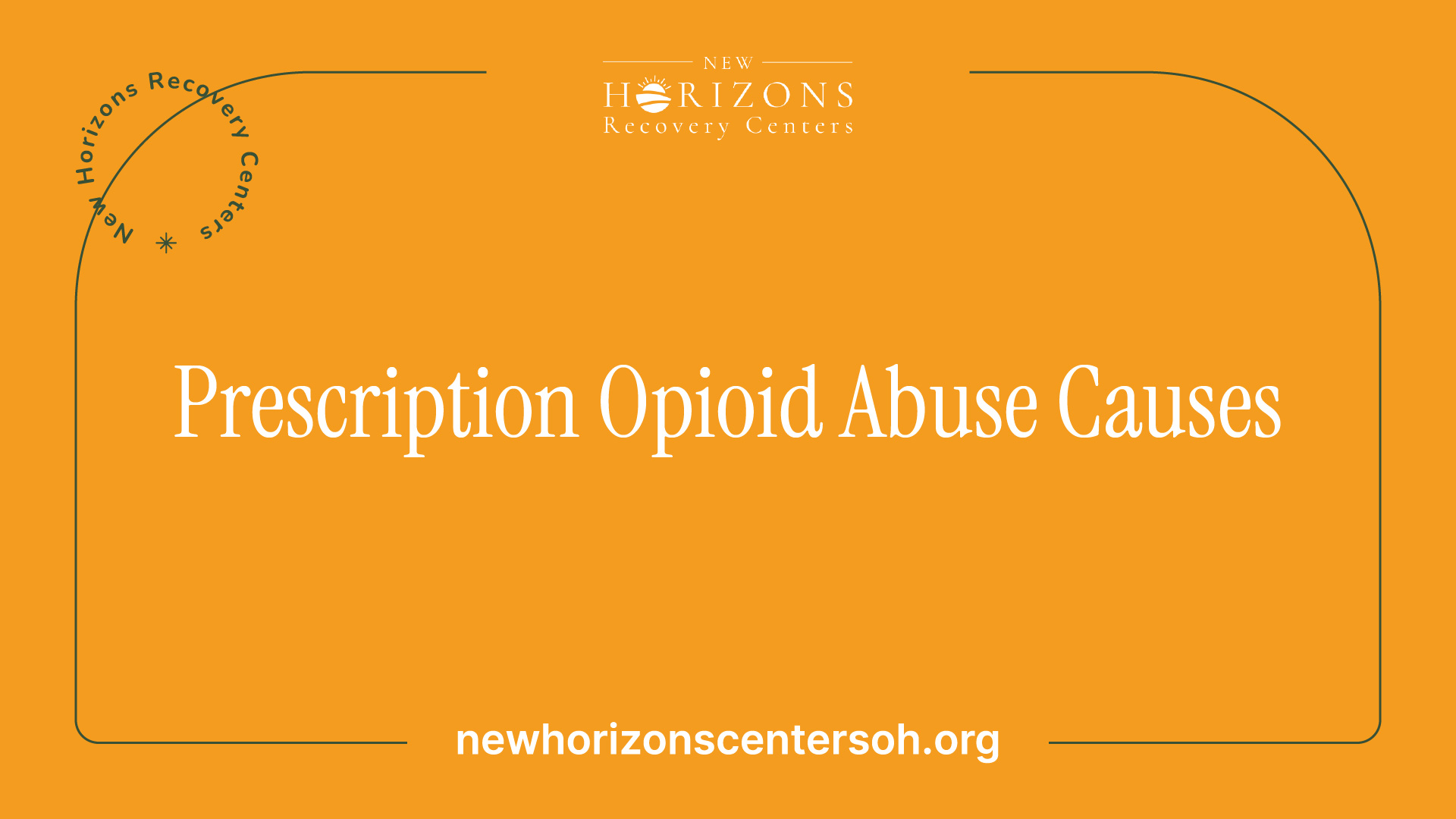Understanding Prescription Opioid Abuse
Prescription opioid abuse has become a significant public health concern, leading to devastating consequences for individuals and communities. Understanding the underlying causes and impact of this epidemic is crucial in addressing this issue effectively.

Opioid Misuse Risk Factors
Several risk factors contribute to the misuse and addiction of prescription opioids. These include past or current substance abuse, untreated psychiatric disorders, younger age, and social or family environments that encourage misuse. Individuals with substance abuse and psychiatric comorbidities, particularly those in middle age, are at higher risk of opioid mortality prevalence.
It's important to note that not everyone who uses prescription opioids will develop an addiction. However, these risk factors increase the likelihood of misuse and dependence. Healthcare providers play a vital role in identifying these risk factors and implementing appropriate strategies to mitigate the potential for opioid abuse.
Impact of Opioid Epidemic
The opioid epidemic has had a profound impact on society, resulting in alarming statistics and devastating consequences. In the United States, over 75% of drug overdose deaths in 2021 involved opioids, with more than 25 people dying every day from a heroin overdose.
The availability of opioids has contributed to the widespread abuse and overdose crisis. In 2021, the number of overdose deaths involving opioids, including prescription opioids, heroin, and synthetic opioids like fentanyl, was 10 times higher than in 1999. Synthetic opioids were implicated in nearly 88% of these deaths, highlighting the dangers associated with these potent substances [3].
These statistics underscore the urgent need for comprehensive measures to address the opioid epidemic. Efforts should focus on prevention, treatment, and collaboration among healthcare professionals, policymakers, and community organizations.
By understanding the risk factors for opioid misuse and recognizing the impact of the opioid epidemic, we can work towards implementing effective strategies to combat prescription opioid abuse. It is essential to prioritize education, awareness, and evidence-based interventions to prevent addiction, promote responsible prescribing practices, and support those affected by opioid use disorder.
Statistics and Trends
Examining the statistics and trends surrounding prescription opioid abuse provides insight into the magnitude of the problem and its impact on society. Understanding these numbers is crucial in raising awareness and addressing the causes of prescription opioid abuse.
Opioid-Related Overdose Deaths
Opioid-related overdose deaths have reached alarming levels, illustrating the severity of the crisis. In the United States, over 75% of drug overdose deaths in 2021 involved opioids, with more than 80,000 people losing their lives to opioid overdoses. This number represents a significant increase compared to previous years, as the overdose deaths involving opioids in 2021 were 10 times higher than in 1999. Synthetic opioids, such as fentanyl, accounted for nearly 88% of these deaths.
Rise in Opioid Addiction Cases
The rise in opioid addiction cases further highlights the widespread nature of the problem. From 1999 to 2021, the number of people who died from a drug overdose involving any opioid, including prescription and illicit opioids, was nearly 645,000 [4]. Over 75% of the approximately 107,000 drug overdose deaths in 2021 involved an opioid.
It is important to note that the misuse of prescription opioids can contribute to the transition to heroin use. Data from 2011 indicates that between 4 to 6 percent of individuals who misuse prescription opioids eventually switch to using heroin, with approximately 80 percent of people who used heroin initially misusing prescription opioids [5]. This highlights the interconnectedness between prescription opioids and illicit drugs.
The statistics and trends surrounding opioid-related overdose deaths and the rise in opioid addiction cases underscore the urgent need to address the causes of prescription opioid abuse. By understanding the magnitude of the issue, policymakers, healthcare professionals, and communities can work together to implement effective prevention strategies and treatment interventions.
Health Risks and Consequences
Prescription opioid abuse can have severe health risks and consequences, affecting both the physical and mental well-being of individuals. Understanding these risks is crucial in addressing the opioid epidemic and promoting safer pain management options.
Long-Term Opioid Therapy Risks
Long-term opioid therapy, particularly when not properly managed, carries various risks and potential complications. It is important to note that the risk for opioid overdose increases significantly with higher doses among patients receiving long-term opioid therapy. Some potential risks associated with long-term opioid therapy include:
- Opioid Addiction: Prolonged use of opioids can lead to substance use disorder (SUD) or addiction. The changes in the brain caused by repeated opioid misuse contribute to the development of addiction, which can have a profound impact on an individual's life and responsibilities [5].
- Overdose: Misuse of prescription opioids can cause slowed breathing, leading to hypoxia, a condition where the brain receives insufficient oxygen. This can result in short- and long-term neurological and psychological effects, including coma, permanent brain damage, or even death.
- Medical Complications: Long-term opioid therapy is associated with various medical complications, which can significantly impact an individual's overall health. These complications may include serious fractures, breathing problems during sleep, hyperalgesia (increased sensitivity to pain), immunosuppression, chronic constipation, bowel obstruction, myocardial infarction, and tooth decay secondary to xerostomia [6].
Medical Complications and Overdose
The misuse of prescription opioids can have severe consequences, both in terms of physical health and overall well-being. Some of the medical complications and risks associated with prescription opioid abuse include:
- Respiratory Depression: Opioids depress the central nervous system, including the respiratory system. In cases of overdose or misuse, this can lead to slowed or stopped breathing, potentially resulting in hypoxia and even death.
- Increased Sensitivity to Pain: Prolonged use of opioids can lead to hyperalgesia, a condition where individuals become more sensitive to pain. This can exacerbate the perception of pain, making it more challenging to manage.
- Withdrawal Symptoms: When individuals dependent on opioids abruptly stop or reduce their use, they may experience severe withdrawal symptoms. These symptoms can include muscle aches, nausea, vomiting, diarrhea, anxiety, insomnia, and intense cravings for the drug.
- Impact on Mental Health: Opioid abuse can have a significant impact on mental health, contributing to the development or worsening of conditions such as depression, anxiety, and other mood disorders.
- Social Consequences: The consequences of prescription opioid abuse extend beyond physical health. Individuals may experience strained relationships, financial difficulties, legal issues, loss of employment, and social isolation.
Understanding the health risks and consequences of prescription opioid abuse is vital in developing effective prevention strategies, promoting responsible prescribing practices, and providing appropriate treatment and support for individuals struggling with opioid addiction. It is essential to address the underlying factors that contribute to opioid misuse, such as risk factors, societal influences, and the historical context of opioid prescriptions, to create a comprehensive approach to combat the opioid epidemic.
Prescription Opioids vs. Illicit Drugs
Prescription opioids, although legally prescribed for pain management, have become a significant cause of substance abuse and addiction. Understanding the risks associated with prescription opioids and their relationship to illicit drugs is crucial in combating the epidemic of opioid abuse.
Opioid Interaction Risks
One significant risk of prescription opioids lies in their potential interactions with other medications. Taking certain medications alongside opioids without the guidance of a healthcare provider can lead to severe drowsiness, decreased awareness, breathing problems, coma, or even death due to interactions. It is essential to consult with a healthcare professional and carefully read FDA information before combining medications to mitigate these risks.
Additionally, opioids interacting with other substances, such as alcohol or benzodiazepines, can increase the risk of overdose, arrhythmias, or seizures. These interactions further emphasize the need for caution and consultation with healthcare providers and pharmacists before combining medications.
Misuse and Transition to Heroin
The misuse of prescription opioids can have severe consequences, including the transition to using heroin. Data from 2011 revealed that between 4 to 6 percent of individuals who misuse prescription opioids eventually switch to using heroin, with approximately 80 percent of people who used heroin initially misusing prescription opioids. The accessibility and similarity between prescription opioids and heroin contribute to this transition.
Prescription opioids can be highly addictive, leading individuals to feel relaxed and experience a "high" when used for non-medical purposes [5]. This addictive nature increases the risk of overdoses and even death.
Addressing the misuse and transition to heroin requires comprehensive prevention strategies, collaboration between healthcare providers, policymakers, and the community, and increased access to effective addiction treatment programs.
Understanding the risks associated with prescription opioids and their potential relationship to illicit drugs is essential in combating the widespread issue of prescription opioid abuse. By addressing these risks and implementing preventive measures, we can work towards reducing the harm caused by opioid misuse and addiction.
Addressing Prescription Opioid Abuse
In order to effectively address the issue of prescription opioid abuse, it is crucial to implement prevention strategies and foster collaboration among various stakeholders. By taking proactive measures and working together, we can make significant progress in combating this public health crisis.
Prevention Strategies
Prevention is a key component in addressing prescription opioid abuse. It involves implementing measures to reduce the likelihood of individuals developing opioid use disorder or experiencing overdose. Some effective prevention strategies include:
- Enhanced Prescription Drug Monitoring Programs (PDMPs): PDMPs are electronic databases that track the prescribing and dispensing of controlled substances. By providing healthcare professionals with access to this information, they can identify and intervene in cases of potential misuse or excessive prescribing.
- Education and Awareness Programs: Raising awareness about the risks and potential consequences of prescription opioid abuse is vital. Educational campaigns targeted at both healthcare providers and the general public can help promote responsible prescribing practices and educate individuals about the dangers of misuse.
- Safe Disposal Programs: Proper disposal of unused or expired prescription opioids is crucial to prevent diversion and misuse. Implementing safe disposal programs, such as take-back events and permanent disposal sites, encourages individuals to dispose of their medications safely.
- Pain Management Alternatives: Exploring non-opioid pain management alternatives can help reduce the reliance on prescription opioids. This may involve utilizing physical therapy, non-opioid medications, or alternative treatments for pain management.
Importance of Collaboration
Collaboration among various stakeholders is essential for success in addressing prescription opioid abuse. This includes:
- Medical Personnel: Healthcare providers play a crucial role in preventing and managing prescription opioid abuse. They should receive training on responsible prescribing practices, early identification of opioid use disorder, and effective pain management alternatives.
- Emergency Departments and First Responders: Collaboration between emergency departments and first responders is vital for timely identification and response to opioid overdoses. Initiatives such as naloxone distribution programs can save lives by reversing opioid overdoses.
- Mental Health Providers: Individuals with mental health conditions are at a higher risk for opioid misuse. Collaboration between mental health providers and primary care providers can ensure comprehensive care and address both mental health and substance use disorders.
- Public Health Officials: Public health officials play a critical role in implementing prevention programs, collecting data, and coordinating efforts to combat prescription opioid abuse. They can provide guidance and support to other stakeholders, ensuring a unified approach in addressing this issue.
- Community Organizations and Advocacy Groups: Collaboration with community organizations and advocacy groups can help raise awareness, reduce stigma, and provide support services for individuals affected by prescription opioid abuse.
By working together and implementing evidence-based prevention strategies, we can make a significant impact in reducing the rates of prescription opioid abuse and its associated harms. Continued collaboration and a multifaceted approach are essential to addressing this complex public health crisis effectively.
Historical Context and Impact
To fully understand the causes of prescription opioid abuse, it is important to consider the historical context and influential factors that have contributed to the opioid crisis. This section will explore the history of opioid prescriptions and the factors that have played a significant role in the current crisis.
Opioid Prescription History
In the mid-1980s and early 1990s, there was a notable increase in the frequency of opioid prescriptions. This shift was largely influenced by the claims made by medical experts, such as neurologist Russell Portenoy, MD, who suggested that opioids had minimal risk of addiction and advocated for their use in managing pain. In fact, some experts even declared that untreated pain could amount to medical negligence. These assertions led to opioids being considered the fifth vital sign in many American hospitals, contributing to a surge in opioid prescriptions.
By 2011, the United States, with only 5% of the world's population, accounted for a staggering 75% of the world's opioid prescriptions. The overprescribing of opioids has had devastating consequences, with an estimated 50% of opioid overdose deaths linked to physicians' prescriptions. From 1999 to 2014, the number of opioid prescriptions quadrupled, resulting in over 165,000 deaths related to opioid overdose.
It is worth noting the role played by pharmaceutical companies in the opioid crisis. Purdue Pharma, the manufacturer of OxyContin, provided substantial funding to Dr. Portenoy and his pain center. Dr. Portenoy, who played a significant role in promoting the use of opioids for chronic pain, admitted to financial relationships with numerous pharmaceutical companies, many of which produce opioid painkillers. These financial ties raise concerns about conflicts of interest and the credibility of research funded by these companies.
Influential Factors in the Opioid Crisis
Several factors have contributed to the opioid crisis and the widespread abuse of prescription opioids. Some of these factors include:
- Lack of awareness about the addictive nature of opioids: The initial belief that opioids had minimal risk of addiction led to a lack of awareness among healthcare professionals and patients about the potential dangers of these medications.
- Overprescribing and aggressive marketing: The increase in opioid prescriptions can be attributed to aggressive marketing strategies employed by pharmaceutical companies, as well as the influence of medical professionals who advocated for the use of opioids in managing pain.
- Patient demand for pain relief: The desire for pain relief among patients, coupled with the perception that opioids were a quick and effective solution, contributed to the demand for these medications.
- Inadequate pain management alternatives: Limited access to alternative pain management options, such as physical therapy, non-opioid medications, and psychological interventions, also played a role in the reliance on opioids for pain relief.
- Socioeconomic factors: The opioid crisis has affected individuals across various social strata, including white middle-class families from diverse professions. This highlights that opioid addiction does not discriminate and can impact individuals from all walks of life [8].
In response to the opioid crisis, organizations like the Centers for Disease Control and Prevention (CDC) have issued guidelines against long-term opioid prescriptions for chronic pain. These guidelines emphasize that opioids are not effective in most non-cancer chronic pain conditions and highlight the risks associated with long-term opioid therapy, including the development of tolerance and increased sensitivity to pain (hyperalgesia). This underscores the need for caution in prescribing opioids for chronic pain.
Understanding the historical context and influential factors behind the opioid crisis is crucial in addressing prescription opioid abuse. By recognizing the issues that have contributed to this epidemic, healthcare professionals, policymakers, and society as a whole can work towards implementing effective prevention and intervention strategies to combat this ongoing public health crisis.
References
[1]: https://pubmed.ncbi.nlm.nih.gov/29049118/
[5]: https://nida.nih.gov/publications/drugfacts/prescription-opioids
[6]: https://www.ncbi.nlm.nih.gov/pmc/articles/PMC3280085/
[7]: https://www.dol.gov/agencies/owcp/opioids/riskfactors
[8]: https://www.ncbi.nlm.nih.gov/pmc/articles/PMC6139931/







